
Master Bond features an extensive line of heat resistant adhesives, sealants, coatings and potting/encapsulation compounds that can withstand temperatures as severe as 600°F and higher. These materials were designed to resist short term and long term exposure to elevated temperatures while maintaining their mechanical and electrical properties.
Adhesives chemistries and heat resistance
Epoxies are the most versatile adhesives at functioning across a wide temperature range, resisting temperatures from 250°F to 650°F. But other adhesive chemistries, such as silicones, UV curable systems and sodium silicate based coatings offer high temperature resistance in combination with highly desirable performance properties. The chart below illustrates temperature resistant values that can be achieved for select grades of different chemistry type systems:
| System Type | Product | Curing | Temperature Resistance |
|---|---|---|---|
| One part epoxy | EP17HT-LO | Heat curing | 600°F (316°C) |
| Two part epoxy | EP42HT-2 | Room temperature curing | 450°F (232°C) |
| Two part epoxy | EP45HTAN | Heat curing | 500°F (260°C) |
| One part silicone | MasterSil 800 | Room temperature curing | 572°F (300°C) |
| Two part silicone | MasterSil 972TC-LO | Room temperature or heat curing | 400°F (204°C) |
| UV curing | UV25 | UV light (with optional heat post cure) | 500°F (260°C) |
| Sodium silicate | MB600SCN | Room temperature or heat curing | 700°F (371°C) |
Selecting high temperature resistant adhesive
Selecting the right adhesive product for extreme temperature application requires analyzing the following factors:
- Expected operating temperature
- Duration of exposure to elevated temperature
- Glass transition temperature (Tg) of an adhesive
- Coefficients of thermal expansion (CTE) of bonded substrates
- Other performance properties requirements (low outgassing, chemical resistance, thermal cycling and shock etc.)
Most engineers tend to pick adhesives rated for higher operating temperatures than needed for their specific applications to ensure a wide safety margin. However, this simplification might lead to trade-offs in performance properties and processing. Master Bond technical experts are ready to help in selecting the right material.
Performance properties of high temperature resistant adhesives
As with all products in the Master Bond family, specific grades vary in viscosity, cure speed, chemical resistance and electrical properties, and can be customized to meet specific application needs.
Special heat resistant grades offer:
- Ultra high compressive strength
- Enhanced dimensional stability
- Thermal conductivity
- Electrical conductivity
- Flame retardancy
- Superb machinability
- Transparency
UV curable single component compositions provide rigid cure and are ideal for high volume productions. B-staged epoxy cookies and films have gained popularity for high temperature usage because of their unique combination of high strength, toughness, flexibility and electrical insulation properties. High performance, one/two components fluorosilicones retain silicone type flexibility, temperature resistance while possessing extraordinary chemical resistance.
Additionally, products are available which meet NASA low outgassing approval, USP Class VI specifications and are halogen free. Our heat resistant systems are presently employed on satellites, downhole oil equipment, automotive components, medical devices, lasers and other industrial applications.
Some of Our Most Popular High Temperature Resistant Systems
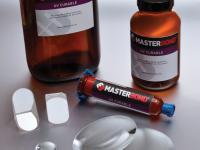 |
UV25 Multi-purpose, one part UV curing system for bonding, sealing, coating and encapsulation. Excellent optical clarity, superb physical properties, moderate viscosity. Ultra high glass transition temperature (Tg) over 180°C. Fast fixture times. Rapid curing. Serviceable from -60°F to +500°F. |
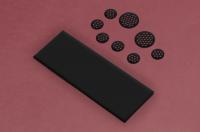 |
FLM36 B-staged film adhesive/sealant. Outstanding thermal cycling capabilities and structural properties. Offers superior toughness and flexibility. Excellent strength retention at elevated temperatures. Thermally conductive/electrically insulative. Provides uniform bond line thickness. Serviceable from -100°F to +500°F. Preforms are available. |
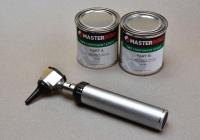 |
EP21TDCHT High strength, high temperature resistant, two part system with excellent bond strength and thermal cycling capabilities. Serviceable from -100°F to +350°F. Meets MIL-STD-883J Section 3.5.2 for thermal stability. Moderate viscosity. Superior toughness. Withstands vibration, impact, shock. Good dimensional stability. Convenient one to one mix ratio. Dependable electrical insulation properties. |
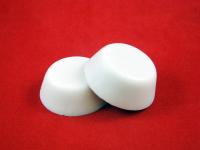 |
EP36AO Thermally conductive, electrically insulative B-stage toughened epoxy. One part system. Ideal for potting and encapsulation. Capable of withstanding rigorous thermal shocks. Serviceable from -100°F to +500°F. Available in 30 gram cookies. Meets NASA low outgassing specifications. |
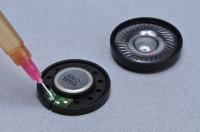 |
EP17HT-LO One part, no mix epoxy meets NASA low outgassing specifications. Serviceable up to 600°F. Tg is 225°C. High shear, tensile and compressive strength properties. Cures in 90-120 minutes at 300F. Withstands 1000 hours 85°C/85% RH. |
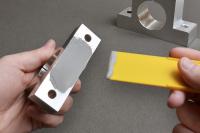 |
Supreme 10HT One part structural epoxy with high bond strength and excellent adhesion to similar and dissimilar substrates, especially composite materials. Requires oven curing at 250-300°F. NASA low outgassing approved. Serviceable from 4k to +400°F. Tough and durable. 85°C/85% RH resistance. |
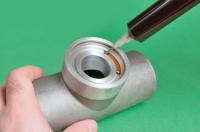 |
Supreme 45HTQ Two component, toughened, quartz filled epoxy with exceptional abrasion resistance. Heat curing system. Long working life after mixing. High compressive strength. Superb dimensional stability. Serviceable from -60°F to +450°F. Withstands exposure to petrochemicals acids, bases, solvents. Good strength retention at elevated temperatures. Successfully tested for 1,000 at 85°C/85% RH. |
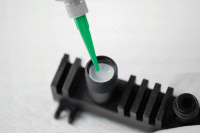 |
EP35AOLV Thermally conductive, electrically isolating epoxy serviceable from -60°F to +500°F. Heat curing, good flow. Superior chemical resistance properties. Long pot life. High compressive strength and dimensionally stable. |
